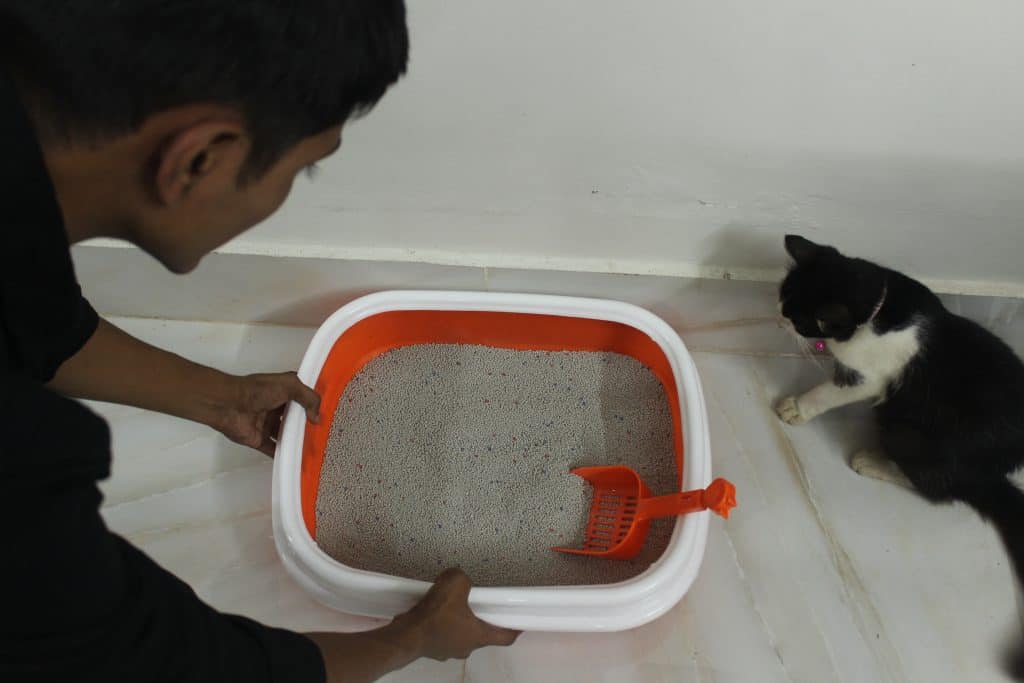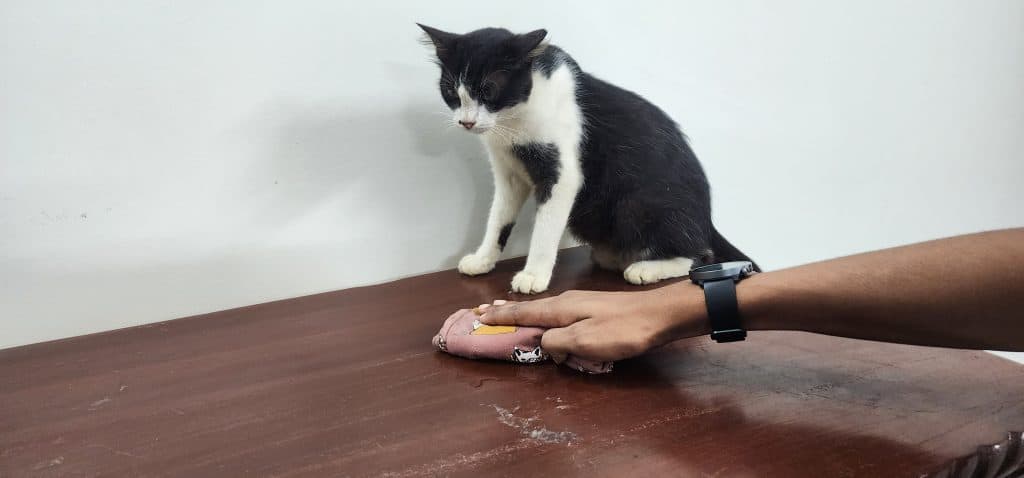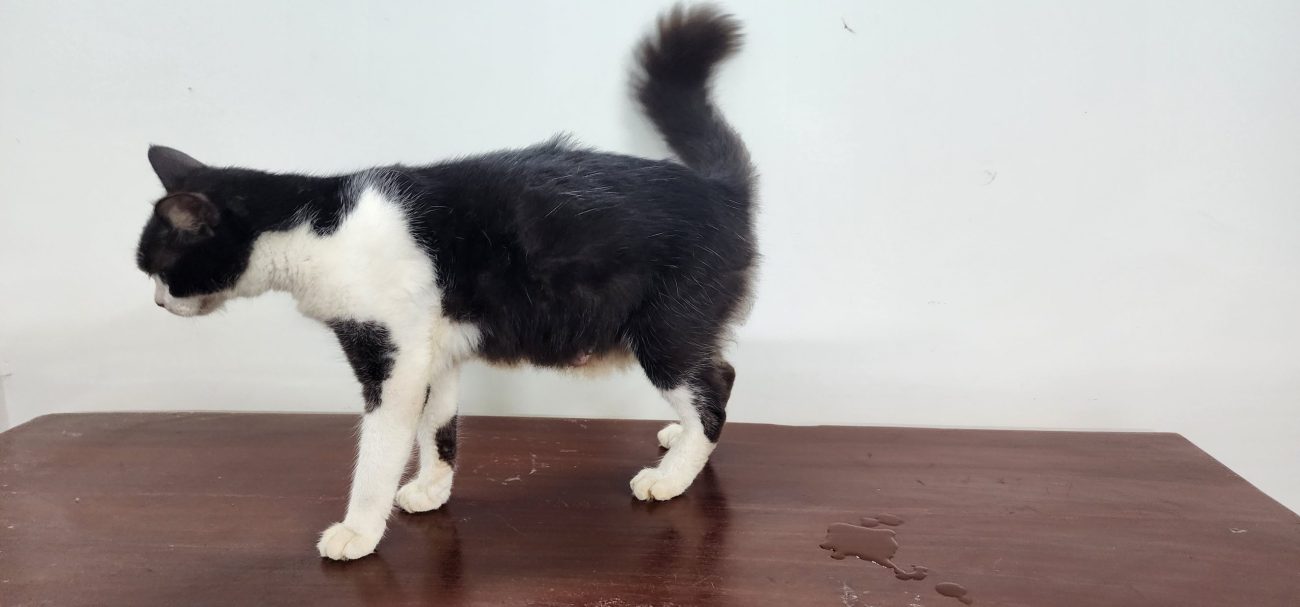Cats are creatures of habit and are naturally inclined to choose specific spots for urination. But if your cat isn’t following its usual routine, peeing outside the litter box, it could be due to some underlying causes. Understanding and analyzing your cat’s behavior can truly help you get to the bottom of the problem.
Now, if you see your cat peeing on baseboards, it can be because of marking territory, underlying medical issues, or litter box problems. Beyond the unpleasant odor, the acidic elements of cat urine can significantly damage baseboards, causing erosion and discoloration. To tackle this, always use enzymatic cleaners to thoroughly clean the affected area, and most importantly, consult with a veterinarian immediately to rule out health concerns.
By taking some practical measures like positive reinforcement or establishing a consistent routine, you can effectively stop your cat from peeing on baseboards and other inappropriate spaces. Knowing Muezza’s behavior and patterns has made this journey easier for me, and I’ll help you with my findings and actionable advice, too.
Why Do Cats Pee on Baseboards?
Sometimes, cats can pee in other places despite having a designated litter box. My Persian cross, Muezza, has also had this problem in the past. But with effective steps, I’ve solved the issue, and so can you.
Here are some of the root causes behind this problem that I’ve noted –
Marking Territory
Cats are territorial animals, and one significant way they communicate and set boundaries is by urine markings, often called spraying.
Particularly if there are other cats in the home, or due to recent changes to the surroundings (like new furniture, visitors, or even a new pet outside), your feline friend may try to mark its territory by peeing on baseboards. This is a common behavioral issue
Medical Issues
A cat’s inappropriate urination can very often be caused by serious medical conditions. This is why it’s absolutely crucial to rule out any underlying health issues first that might be causing your cat pain or discomfort and making them avoid the litter box. I always make sure to get Muezza checked by our vet if any peeing issues arise.
Increased urgency and frequency of urination, straining, or even vocalizing while attempting to pee can be symptoms of common diseases, including painful bladder stones, urinary tract infections (UTIs), or feline lower urinary tract disease (FLUTD). These conditions can cause your cat to associate pain with the litter box, leading them to look for alternative, more “comfortable” places to relieve themselves.
In severe cases, a urinary blockage, especially in male cats, can be life-threatening and requires immediate emergency veterinary care.
[American Veterinary Medical Association – Feline Lower Urinary Tract Disease]
Litter Box Problems
Another reason a cat might not want to use a litter box is problems with the box or the litter itself.
Cats are picky about their bathroom habits; even small adjustments can cause them to avoid using the litter box. Common litter box issues include:
● Dirty or Inadequate Litter Box Maintenance
Cats prefer clean litter boxes and may avoid using them if they are soiled or not cleaned regularly. Think about it – would you want to use a dirty restroom?
● Inappropriate Litter Type
Cats have strong preferences for litter texture, scent, and depth. If the litter doesn’t meet their preferences (e.g., too dusty, too heavily scented, too shallow), it may discourage them from using the litter box.
● Location and Accessibility
Cats prefer a quiet and private area for their litter boxes where they feel secure. Placing the litter box in a high-traffic, noisy area, or one that’s hard to access can make them feel vulnerable and uncomfortable.
Understanding these potential root causes has helped me to take the appropriate steps to address the underlying issues for Muezza.
What Are the Common Peeing Patterns of Cats With Issues?
Addressing the issue of a cat peeing on baseboards requires careful observation and identification of any noticeable signs and patterns. I suggest paying attention to your cat’s behavior for crucial insights into the reasons behind this bad habit.
Here are three key signs I noticed in Muezza:
Frequent but Irregular Urination
Addressing the issue of a cat peeing on baseboards requires careful observation and identification of any noticeable signs and patterns. I suggest paying close attention to your cat’s behavior for crucial insights into the reasons behind this unwanted habit.
Here are three key signs I noticed in Muezza that indicated something was off:
Frequent but Irregular Urination
Your cat urinating more frequently than usual, or in unusual spots, is one of the first indications of a potential issue. Multiple trips to the bathroom, or frequent small puddles of urine in various locations around the house, may be signs of a health concern like a kidney or urinary tract infection.
Small volumes of urination at a time, or straining to urinate, might also be an indication of discomfort or a partial blockage.
Peeing Near Baseboards
The specific location of your cat’s urination can also provide important clues. If you find urine spots near baseboards, walls, or other vertical surfaces, it may indicate territorial marking behavior, especially if the urine is sprayed rather than a full squatting puddle. Cats use their urine to leave scent markings, and vertical surfaces are preferred locations for this form of communication.
Remember that urine spraying, which typically involves a cat backing up to a vertical surface and releasing a small amount of urine, is different from regular urination (squatting), and is usually seen as a behavior related to territorial marking or stress.
Behavioral Changes
If your cat becomes more aggressive, anxious, withdrawn, or vocal, it might be a response to changes in the home environment or stress related to a medical condition.
Cats may also become more vocal, display signs of distress (like hiding more), or show changes in appetite if they are experiencing discomfort or pain from a urinary issue. Any sudden change in behavior warrants a closer look and often a vet visit.
How to Stop Cats from Peeing on Baseboards?
Now that you understand the potential causes and patterns of the problem, it’s time to know how to stop your pet cat from peeing on baseboards.
For my Muezza, there were no underlying medical issues but rather behavioral changes due to several reasons. However, I always make sure to visit the vet first, as ruling out medical issues is the most important first step.
After getting the all-clear from our veterinarian, I visited an animal behaviorist to determine the reasons behind Muezza’s inappropriate urination. These professionals specialize in understanding feline behavior and can assess the situation to identify potential triggers and effective solutions. The trainer considered factors such as changes in the home environment, stressors, or interactions with other pets. He treated my Muezza by advising the following measures:
- Environmental Enrichment: Recommending interactive games, scratching posts, or toys to keep Muezza cognitively and physically engaged and reduce boredom-related stress.
- Desensitization and Counterconditioning: Using reward-based training and gradual exposure to help her develop positive associations with the litter box and reduce anxiety around it.
By the way, that doesn’t mean your cat should have the exact same issues or solutions. So, you should consider the following measures to resolve the peeing issues of your cat on baseboards
Treat the Medical Conditions
Making sure your cat’s health is in order is the absolute first and most critical step in dealing with incorrect urinating. Always visit the veterinarian for a thorough examination as soon as you notice inappropriate urination.
The vet will examine your cat’s overall health and perform necessary tests, such as urinalysis and blood work, to check for any underlying medical conditions like urinary tract infections, kidney issues, or diabetes. Addressing these health problems will often resolve the peeing issue.
Address the Litter Box Problems
A cat’s litter box preferences are essential to ensure they consistently use it. Evaluate your current litter box setup to ensure it meets your cat’s needs.
- Cleanliness is Key: Keep the litter box impeccably clean by scooping it at least once a day and changing the litter regularly (e.g., weekly or bi-weekly depending on the litter type). Cats are fastidious!
- Right Litter Type: I experimented with different litter textures and scents to find the one Muezza prefers – some cats like unscented, fine-grained litter, while others prefer something different.
- Optimal Placement: Place the litter box in a quiet, private, and easily accessible area away from busy spots or noisy appliances. Consider having multiple litter boxes in different locations, especially in multi-cat households (a good rule of thumb is one box per cat plus one extra).

Prevent the Stress and Anxiety
Cats are sensitive creatures and can be easily stressed by changes in their environment or routine. They thrive on consistency, so try to stick to a predictable daily routine for feeding, playtime, and quiet time. I keep a designated, secure area at home where Muezza can retreat and feel safe and secure when she needs to. You can also use feline pheromone sprays or diffusers like Feliway Optimum to help reduce stress and create a calming environment in your home.
Reinforce Positive Behaviors
Positive reinforcement can play a significant role in encouraging desired behaviors. Give your cat praise, food, or affection when it uses the litter box correctly.
This positive association can help reinforce the litter box as the preferred spot for urination.
Tips for Cleaning and Maintaining a Safe Space
Besides addressing the underlying causes, you also need effective cleaning and prevention strategies. For Muezza, I make sure to –
Clean the Affected Area Fast

It’s important to clean any affected areas immediately if your cat urinates there or in other improper places. Use paper towels to blot up as much urine as possible without spreading it further. I’d strongly advise avoiding using ammonia-based cleaners since they may smell like cat urine to your cat and could actually draw your cat back to the same location.
Instead, use mild dish soap or a mixture of water and white vinegar (1:1 ratio) to clean the area thoroughly. Rinse thoroughly with clean water afterward.
Use Enzymatic Cleaners

To truly get rid of the stubborn cat urine smell effectively, you must use enzymatic cleaners specifically designed to break down the proteins and uric acid crystals in cat pee.
These cleaners work by breaking down the odor-causing molecules, ensuring that the scent is removed completely, preventing your cat from being attracted back to the spot.
Always follow the manufacturer’s instructions carefully when using enzymatic cleaners for best results.
Prevent Access to Spaces
To protect baseboards and walls from further urination, you can stop your cat from accessing them. I use baby gates or other barriers for Muezza.
Cats dislike the texture of aluminum foil and plastic carpet runners, making them effective deterrents. You can place them on the baseboards or near the problem areas.
I applied double-sided tape to the baseboards to discourage Muezza from approaching those spots due to the sticky texture.
FAQs
Since the issue is unknown to many, people often ask questions regarding cats peeing on baseboards. Here, I have answered some common questions based on my experience with Muezza –
Q. Does the cat pee smell go away?
Yes, the cat pee smell can go away completely, but it usually requires the use of a high-quality enzymatic cleaner that breaks down the uric acid crystals. Regular cleaning products often only mask the odor, which can still be detected by a cat’s sensitive nose, leading to repeat marking.
Q. Can cat urine be toxic to health?
While direct contact with fresh cat urine is generally not highly toxic, prolonged exposure to soiled litter boxes or uncleaned urine can generate mild health concerns. This includes the potential for bacterial growth (like Toxoplasma gondii from cat feces, though less directly from urine), which can pose risks, especially to pregnant women or immunocompromised individuals. Over time, the ammonia fumes from stale cat urine can also cause respiratory irritation or allergic reactions in sensitive individuals. Always ensure good ventilation and hygiene when dealing with cat waste.
Q. Can medications refrain cats from peeing on baseboards?
In some cases, especially when stress or anxiety is the primary underlying cause, veterinarians may prescribe anti-anxiety medications or other behavior-modifying drugs to address inappropriate urination. However, medication is typically used in conjunction with environmental and behavioral modifications, and should only be considered after a thorough veterinary examination and diagnosis. Always consult your vet before considering any medication for your cat.
Final Thoughts
If you have pet cats at home, you’re bound to deal with some responsibilities and challenges. To solve issues like your cat peeing on baseboards, it’s important to be patient, observant, and proactive.
Always look out for any patterns in your cat’s behavioral changes and make sure to consult with a veterinarian first and foremost to rule out any underlying medical issues. Once health concerns are addressed, you can focus on environmental adjustments and positive reinforcement.
Remember, you can effectively clean up messes with enzymatic cleaners and use calming pheromone sprays to help soothe your cat’s anxiety! Dealing with inappropriate urination can be a journey, but with understanding and consistent effort, you can help your cat get back to using their litter box properly.




